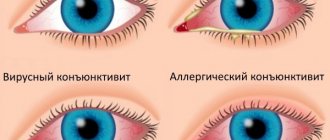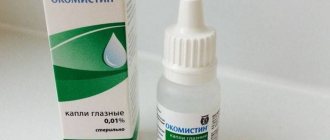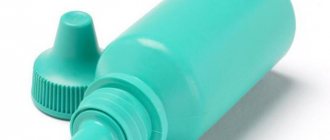- Rules for the rational treatment of conjunctivitis
- Drops for the treatment of bacterial conjunctivitis
- Eye drops for viral conjunctivitis
- Features of the treatment of allergic conjunctivitis
- Medicines to combat fungal conjunctivitis
- Rules for using eye drops
- How to treat conjunctivitis in children
At first glance, conjunctivitis seems to be a fairly harmless and harmless disease, which is why many people decide to treat it themselves.
This is their main mistake. The fact is that the disease can be bacterial, viral, fungal or even allergic in nature. Moreover, each individual type of conjunctivitis requires the prescription of completely different drugs. Using inappropriate eye drops will not only not help you recover, but will also harm the person (for example, using antibiotics for a fungal infection of the conjunctiva will only worsen the course of the disease and slow down the healing process). Therefore, medications must be selected individually in each individual case. Drops should only be prescribed by a qualified ophthalmologist after a preliminary examination and examination of the patient.
Rules for the rational treatment of conjunctivitis
Before starting treatment, the doctor determines the type of conjunctivitis. Bacterial inflammation is characterized by the appearance of purulent discharge in the conjunctival cavity. At the same time, a person’s eyelids stick together, and it becomes difficult for him to open his eyes in the morning. In this case, the prescription of antibiotics is justified.
For viral conjunctivitis, which is manifested by lacrimation, redness of the eyes and the appearance of mucous discharge, antiviral agents and immunomodulators are needed. In case of severe disease or the addition of keratitis, systemic antiviral drugs (tablets) may be prescribed. Inflammation of the conjunctiva of a fungal nature requires the use of antifungal drugs.
People with various types of allergic conjunctivitis need hyposensitizing agents and steroid hormones. To prevent seasonal allergic reactions, specific hyposensitization using small doses of allergens is widely used. Preparations from the group of mast cell membrane stabilizers (Cromoglycic acid) help ease the course of spring conjunctivitis.
Types of conjunctivitis
Conjunctivitis is an inflammatory lesion of the conjunctiva, which is manifested by congestion of blood vessels (hyperemia) and swelling of the mucous membranes of the eye, swelling and itching of the eyelids, the appearance of pathological mucous or purulent discharge.
Inflammation of the conjunctiva is a fairly common disease; about 40% of all ophthalmological diseases are lesions of the mucous membrane of the eye. This prevalence is facilitated by a large number of reasons that contribute to the development of this inflammation. The main ones are:
- bacteria – staphylococci, streptococci, pneumococci, etc.
In the case of bactericidal infection, it manifests itself as an independent disease.
- viruses – adenoviruses (most often), smallpox, measles, herpetic.
When the body is infected with a virus, conjunctivitis is a secondary manifestation of infection.
It appears most often in cases of general weakening of the immune system and is quite rare.
- chlamydia - microbes.
Chlamydial conjunctivitis affects people who have been diagnosed with chlamydia of the genitourinary tract, and its development is possible in newborns as a result of infection during childbirth from a sick mother. It is not uncommon for chlamydia to develop after visiting public baths or swimming pools.
- non-infectious factors - dust, smoke, various chemicals, pollen and other allergens.
These factors most often cause allergic conjunctivitis, which most often has a seasonal manifestation.
In addition to the main reasons mentioned, inflammation of the mucous membrane of the eye can occur against the background of a severely weakened immune system (for example, with tuberculosis, HIV), various vision pathologies, mechanical trauma to the eye, poor hygiene when wearing contact lenses, dry eye syndrome, etc.
Based on the causes of inflammation, there are 5 main types of disease:
- bacterial – more common in children;
- viral – as a secondary manifestation of infections caused by viruses;
- allergic – seasonal;
- chlamydial – “bath”;
- fungal.
Regardless of the origin, the disease has manifestations characteristic of all its types. Most often this is:
- swelling;
- increased fullness of the blood vessels of the mucous membrane of the eye;
- itching and burning;
- sensation of a foreign body in the eye;
- increased lacrimation;
- increased sensitivity to light.
In addition to the general symptoms, each type of conjunctivitis has specific manifestations, which are more specifically described in the table below.
| Type of conjunctivitis | Specific manifestations |
| Bacterial | Sharply appearing hyperemia of the mucous membrane, swelling of the eyelid, a feeling of “sand” in the eyes, mucopurulent discharge, after sleep - sticky eyelashes, severe itching and burning in the eye area. Most often, one eye is affected, but over time, symptoms appear in the second. Characterized by a high level of infectivity. Transmitted through household items - towels, bed linen, etc. |
| Viral | Herpetic conjunctivitis: photophobia, excessive lacrimation, blepharospasm (involuntary closure of the eyelids), the appearance of watery blisters on the eyelids, as well as their redness and swelling. Adenoviral conjunctivitis: mucous discharge, burning, stinging, feeling of “sand” in the eyes, redness of the conjunctiva and eyelids, increased sensitivity to light, lacrimation. Both eyes are affected at once. It is transmitted through contact with a sick person, through hands, household items, etc. |
| Allergic | Severe itching and burning under the eyelids, increased lacrimation and photosensitivity, mucous discharge, possible development of blepharospasm. Both eyes are affected at the same time. Not contagious. |
| Fungal | Symptoms may vary depending on the type of mycosis that caused the inflammation. |
| Chlamydial | Severe swelling of the eyelids and mucous membranes of the eye, copious discharge of mucus and pus from the conjunctival sac, enlarged lymph node near the auricle. It is highly contagious and spreads quickly through household contact. |
Treatment of all types of disease is based on eliminating the causes of the inflammatory process, as well as relieving unpleasant symptoms. For this purpose, medications are used in the form of solutions injected into the eyes.
Drops for the treatment of bacterial conjunctivitis
To treat bacterial conjunctivitis, antiseptics, antibiotics, regenerative agents, steroidal and non-steroidal anti-inflammatory drugs are used. In some cases, antiallergic medications are included in the treatment regimen.
In order to remove purulent contents, the eyes are washed with a solution of furatsilin (1:5000), 2% boric acid or an aqueous solution of potassium permanganate. After this, special drops with antibiotics and other medications prescribed by the doctor are dripped into the conjunctival cavity. At night, it is recommended to apply antibacterial ointment (Floxal) behind the lower eyelid.
Tsipromed
A modern broad-spectrum antibiotic from the florquinolone group. Available in 5 ml dropper bottles. Used for conjunctivitis, blepharitis, dacryocystitis, anterior uveitis and other inflammatory eye diseases. For acute inflammation of the conjunctiva, Tsipromed can be instilled up to 8-10 times a day. The frequency of instillations and duration of treatment are determined by the ophthalmologist.
Tobrex
It is an antibiotic of the aminoglycoside series. Effective in treating almost all bacterial eye infections. Available in the form of ointments and drops of various concentrations. The frequency of administration of the drug and the duration of treatment are determined by the treating ophthalmologist on an individual basis.
Instead of Tobrex, you can use its analogues (Tobramycin, Tobropt or Dilaterol). It is also possible to prescribe the combination drug Tobradex, which also contains the corticosteroid dexamethasone. These drops have not only antibacterial, but also a pronounced anti-inflammatory effect.
Phloxal
It has a wide spectrum of antibacterial activity, making it very effective in the treatment of conjunctivitis. Available in the form of drops and eye ointment. The drug is used 2-4 times a day, dropping 1 drop into each eye. The ointment is applied to the lower eyelid 1-2 times a day (necessarily at night). The duration of treatment should not exceed 2 weeks.
Miramistin
A fairly high-quality antiseptic drug that has a pronounced antimicrobial effect. It should be clarified that Miramistin (like its analogues) is not an antibiotic. It can be prescribed along with antibacterial drugs to more quickly cleanse the eyes of harmful microorganisms.
Similar drugs:
- Avitar;
- Ophthalmo-Septonex;
- Vitabact;
- Okomistin;
- Albucid.
Sofradex
A slightly outdated combination drug intended for the treatment of bacterial eye diseases. Available in 10 ml bottles. Contains two antibiotics (gramicidin and neomycin) and a steroid hormone (dexamethasone). The medicine is effective in the treatment of bacterial eye diseases that do not affect the surface of the cornea.
The drug is instilled 3-6 times a day, 1-2 drops. The course of treatment should last no more than 10-14 days. Long-term use of Sofradex is prohibited, as it can lead to the development of severe complications.
Maxitrol
A more modern ophthalmic drug, which includes a corticosteroid (dexamethasone) and antibiotics (neomycin, polymyxin B). The medicine kills infection, relieves inflammation, eliminates itching, discomfort, and redness of the eyes. Apply 3-6 times a day (depending on the severity of the disease).
In case of a pronounced inflammatory process, Maxitrol can be dripped into the conjunctival cavity every 1-2 hours.
Indications for use of drops
The ophthalmic drug Albucid is prescribed for the treatment of bacterial conjunctivitis caused by chlamydia, cocci, E. coli and some other pathogenic microorganisms. For other forms of conjunctivitis, this medicine is ineffective and can provoke an increase in the inflammatory process. For allergic or viral conjunctivitis, sulfacetamide can be used only if secondary infection is observed. Albucid is prescribed for the following pathological conditions in adults and children:
- bacterial conjunctivitis;
- blepharitis;
- barley;
- purulent corneal ulcer;
- keratitis;
- dacryocystitis.
Sometimes drops are prescribed during the rehabilitation period after eye surgery to prevent infection.
Conjunctivitis and its varieties
Conjunctivitis is one of the most common diseases among children and adults. In the latter it occurs much more often.
Conjunctivitis is an inflammatory process that affects the mucous membrane of the organs of vision.
Depending on the causative agent of the infection, medicine distinguishes 3 types of disease:
- Bacterial conjunctivitis. Caused by pathogenic bacteria: diphtheria bacillus, streptococci, pneumococci, staphylococci.
- Viral conjunctivitis. Appears when infected with viruses: adenoviruses, herpes viruses.
- Allergic conjunctivitis. Develops under the influence of negative aggressive environments as a result of allergen getting into the eyes. These are dust, paint ingredients, household chemicals, wool.
Each type of disease has certain symptoms. Only an ophthalmologist can accurately determine which conjunctivitis a child or adult has.
Eye drops for viral conjunctivitis
For inflammation of the conjunctiva of a viral nature, drugs are used that inhibit the activity of viruses. Additionally, the doctor may prescribe immunomodulators - drugs that strengthen the immune system and help the body defeat infection. Instead of corticosteroids, it is preferable to use non-steroidal anti-inflammatory drugs.
Oftan IMU
One of the most popular and effective drugs for topical use in ophthalmology. The product is very effective in the treatment of viral conjunctivitis and superficial keratitis. Oftan IDU is not recommended for use with corticosteroids, as they reduce its effectiveness. The drug can be combined with immunomodulators.
Oftalmoferon
A drug that has antiviral, immunomodulatory and anti-inflammatory effects. It is also quite effective in the fight against herperviral, adenoviral, and enteroviral conjunctivitis. Oftalmoferon is recommended to be used 1 drop 2-4 times a day for 10-14 days.
Other drugs with similar effects:
- Poludan;
- Aktipol;
- Berofor.
Interferons and interferon inducers are usually prescribed in combination with antiviral drugs.
Acyclovir
A fairly well-known antiviral drug, which is available in the form of a 3% eye ointment. As a rule, the medicine is placed into the conjunctival cavity immediately before bedtime. In severe cases of the disease, the drug can be taken orally in tablet form.
Florenal
A synthetic antiviral drug that is especially effective against herpes simplex and herpes zoster viruses. Used to combat viral conjunctivitis, keratitis and keratoconjunctivitis.
Forms of release of the drug:
- 0.1% solution in drops;
- films for placing behind the lower eyelid in packs of 30 pieces;
- 0.5% eye ointment.
Features of use in children
Conjunctivitis is quite common in children due to poor personal hygiene. For inflammation of the conjunctiva in a child, doctors also recommend the use of Albucid drops. However, in this case, it is necessary to purchase a 10% or 20% solution, which should be instilled 2 drops every 3-4 hours. The exact dosage is determined by the doctor, taking into account the baby’s age and stage of the disease. Before using the medicine, the eyes must be cleaned. Sulfacyl sodium is often prescribed to newborns to prevent certain inflammatory eye pathologies. In this case, the solution is instilled 1 drop 6-8 times a day.
Albucid for children is recommended not only for conjunctivitis, but also for rhinitis caused by bacteria. The drug is prescribed only if the snot is green and contains pus. Before instillation, it is necessary to clean the nostrils with a saline solution. To avoid irritation, sulfacetamide should be diluted with water in equal proportions.
Albucid is well tolerated at any age and reviews are mostly positive, however, it is recommended to use it for the treatment of conjunctivitis in children only with a doctor’s prescription.
Author of the article: Kvasha Anastasia Pavlovna, specialist for the website glazalik.ru Share your experience and opinion in the comments.
Rules to follow during the treatment process
When treating conjunctivitis in children, the following rules must be observed:
- The bottle cannot be used to treat several people. This contributes to the spread of infection, especially with viral eye inflammation.
- Do not touch the surface of the child’s eyes, eyelids or face with the dropper while administering the solution.
- If your child wears contact lenses, they must be removed before the procedure. Some drops can be used without removing the lenses.
- If an ointment is prescribed along with the drops, the medicinal solution is used first. When using several types of drops, they must be used alternately, observing the intervals prescribed by the doctor.
- Before treatment, remove purulent and mucous eye discharge. To do this, use sterile swabs moistened with Furacilin solution.
Oftaquix
The drug is approved for use by both adults and children. Oftaquix is indicated for the following viral and infectious eye diseases:
- keratoconjunctivitis;
- keratitis;
- ulcers in the cornea that are bacterial in nature.
The use of the drug in the first few days of therapy should be no more than eight times a day. When improvements appear, instillation is carried out up to four times a day.
When an ophthalmologist prescribes drops for eye infections, their effectiveness can be observed after just a few procedures. This is a partial list of antibacterial eye drops. Listed above are only drugs that most effectively fight eye infections and are popular among patients.
Features of the treatment of allergic conjunctivitis
All persons with allergic conjunctivitis are advised to consult an allergist. To eliminate ocular manifestations of allergies, eye drops are used. Along with special antiallergic drugs, corticosteroids are widely used. These hormones are very effective in combating allergies.
It should be remembered that almost all eye drops for allergies only temporarily relieve the symptoms of the disease. The most effective method of prevention is to avoid contact with the allergen. Therefore, allergy sufferers should spend less time in places where ragweed blooms, exclude allergenic foods from the diet and remove other provoking factors. Specific hyposensitization helps to avoid the development of allergies. You can learn more about this technique at an appointment with an allergist.
Allergodil
It is a long-acting drug that inhibits the release of allergy mediators. Has anti-inflammatory, hyposensitizing, antiallergic effects. It should be noted that the medicine is available not only in the form of eye drops, but also in the form of a nasal spray. Due to this, it is widely used to combat allergic rhinitis in children and adults.
Cromohexal
The medicine is excellent for people suffering from frequent allergic conjunctivitis. Cromohexal is recommended to be used shortly before the allergen begins to act (for example, on the eve of flowering of ragweed or other plants). The drug stabilizes mast cell membranes and prevents the release of allergy mediators. Thus, it allows you to prevent the occurrence of unpleasant symptoms.
Visine
Refers to vasoconstrictors. It literally removes eye redness, itching, discomfort and other unpleasant symptoms in just a few minutes. However, the drug does not eliminate the cause of conjunctivitis, and it can be used for no longer than 4 days. Visine is a medicine that only eliminates the symptoms of the disease. It is usually used together with other drugs.
Dexamethasone
This product is a hormonal drug, so it must be used with extreme caution. The medicine is strictly prohibited for use in the presence of erosions, minor traumatic and inflammatory injuries of the cornea. Dexamethasone is available as a 0.1% solution for eye drops. Typically used in conjunction with antiallergic medications.
Patient opinions about Levomycetin drops
Reviews about the effect of Levomycetin drops in the treatment of conjunctivitis are mostly positive. Among the advantages, patients highlight the rapid action of the drug and high efficiency in the fight against bacteria. Here's what people write about this medication:
Ekaterina, 36 years old: “When purulent conjunctivitis began, the ophthalmologist prescribed several medications at once: tetracycline ointment, Oftalmoferon and Tobrex drops. For everything I needed to spend about 1000 rubles, which I didn’t have. The pharmacist recommended Levomycetin drops for 20 rubles, and said that they were no worse than the above-mentioned medications.
Which drops are best to choose for conjunctivitis?
If this ophthalmological disease is of allergic origin, patients are prescribed antihistamines. If there is no pus, but there is severe swelling of the eyelids, redness of the eye mucosa, irritation and itching caused by viruses, antiviral drops are needed. Means belonging to the category of antibiotics are used in case of infection by streptococci, staphylococci and other types of bacteria.
When considering all the drops from this rating, it is worth saying the following:
- For the bacterial form of the disease, it is best to choose Cipromed or Ciprofloxacin, taking into account the age of the patient.
- If the cause of conjunctivitis lies in the action of viruses, then Sulfacyl-Sodium, Tobrex, Floxal may have the desired effect.
- For allergic types of disease, Ciprofloxacin works well.
- If inflammation occurs as a result of prolonged work at the computer and due to eye fatigue, then you should pay attention to Levomycetin, even though it is an antibiotic.
Watch an episode of a popular TV show about conjunctivitis, from which you will learn a lot of useful information about its symptoms and treatment:
This rating truly includes the best eye drops for conjunctivitis in adults and children, and precisely according to customers. According to these reviews, they are safe, effective and affordable.
Treatment with ointments
Local forms of drugs are popular in the treatment of conjunctivitis. The disease is treated with eye ointments and drops for conjunctivitis. It is better to use the ointment at night, as it forms a film on the surface of the eye that impairs vision. And during the day use drops.
When using ophthalmic agents, short-term side effects from the visual organ are possible: burning, feeling of a foreign body in the eye, lacrimation, eyelid dermatosis, blurred vision. As a rule, symptoms go away on their own within a few minutes. If side effects persist for a long time, intensify, or allergic manifestations occur, then you should stop using the drug.
Ophthalmic forms of drugs have a predominantly local effect and are absorbed into the systemic circulation in minimal quantities. This reduces the risk of developing side effects from other organs and systems.
If inflammatory symptoms are accompanied by dry eyes, then Oftagel gel and Visin drops can be used in combination. These products moisturize the mucous membrane of the eye, improve metabolic processes in cells, and accelerate recovery.
Let us examine in more detail the main names of ointments for the treatment of conjunctivitis in adults and children, their characteristics, and methods of use. A general contraindication to all medications is individual hypersensitivity to the components of the drug. Ointments for conjunctivitis for children under one year of age should be used only under the supervision of an ophthalmologist or pediatrician.
Medicines to combat fungal conjunctivitis
Today, it is difficult to find ready-made antifungal drops on the pharmaceutical market. This is due to the fact that fungal eye infections are quite rare. As a rule, drops for their treatment are prepared manually by diluting powder or tablets. The most commonly used antifungal drugs are Amphotericin B, Nystatin, Miconazole, and Fluconazole.
Antiseptic eye drops are widely used to combat fungal conjunctivitis. Most of them are capable of inhibiting the activity of harmful fungi and curing the disease. As a rule, doctors prescribe Okomistin or Vitabact to their patients.
How to deal with bacteria and viruses
Eye inflammation in children requires special treatment. Eye drops are the most suitable, because they can be administered even to a child up to one year old. They are prescribed by a doctor depending on the type of conjunctivitis.
What products fight best against pathogenic bacteria?
Here is a list of drops that doctors can prescribe against bacterial conjunctivitis:
- Albucid. It is prescribed against the disease most often, because the spectrum of action is quite wide: all types of bacteria, chlamydia, accinomycetes. Its price is low, and the product can be used even for children of the first year of life. It is also recommended to drip this drug into the nose. Disadvantages include a possible burning sensation and, occasionally, redness and itching.
- Fucithalmic. It also helps against various types of bacteria and can be used for children of all ages. The only contraindication is hypersensitivity to the components, in particular to fusidic acid. If after a week of use the results are not noticeable, this medicine should be replaced with another one.
- Ciprofloxacin. Has a wide range of effects. It can only be used by children after they reach one year of age.
- Levomycetin. Also refers to antibiotics for wide use. This product does not sting the eyes, but individual intolerance is possible. Contraindicated for children under two years of age.
- Phloxal. The main active substance here is ofloxacin, which has extremely strong antibacterial properties. This antibiotic does not cause eye irritation and is suitable for treating children of any age, including infants. The disadvantages of this remedy against conjunctivitis include the rather high cost and the fact that after opening the drug can be stored for only a month and a half.
- Tobrex. The main active ingredient (tobramycin) copes well with a variety of bacteria, including streptococci and staphylococci. Does not irritate the eyes. Suitable for children of different ages. The disadvantages include the possibility of an allergic reaction and the rather high cost of the drug.
- Vitabact. Has a wide spectrum of antimicrobial action. It fights not only against bacteria, but also some viruses and most fungi. Treatment is carried out for ten days. The only contraindications are hypersensitivity to the components.
There is also a list of popular drugs for the treatment of viral conjunctivitis.
The following eye drops are suitable for this disease:
- Interferon. This product not only copes well with viruses, but also improves the protective properties of the eyes. It is usually offered in pharmaceutical retail outlets in powder form. Its cost is low. To obtain drops, the powder must be diluted with water. You can store the prepared product for no longer than two days in the refrigerator. The disadvantages include the following property of the drug: with prolonged use it ceases to give a positive result.
- Oftalmoferon. This remedy helps with such conjunctivitis, while simultaneously relieving allergic reactions and strengthening the immune system. It fights well against external symptoms - itching, swelling, redness. This is important, because with conjunctivitis the baby constantly tries to scratch his eyes, which causes the risk of additional infection. You can take the drug until complete recovery without reducing the effect. There are no side effects. The only negative is that after opening the package the shelf life of the drug is only 30 days.
- Florenal. The high therapeutic effect allows you to quickly cure viral conjunctivitis. For children, take a 0.1 percent solution. The only side effect is a slight burning sensation after instillation.
- Tebrofen. Used to combat the herpes virus in children. It is very effective, but may cause a burning sensation.
- Oftan I'm coming. Helps with superficial viral keratitis and conjunctivitis caused by the herpes virus. The product is extremely effective, but has contraindications. Thus, its components can cause an allergic reaction, as well as itching and burning in the organs of vision. Children under two years old should not use such drops.
- Aktipol. Also very good for healing conjunctivitis. It has antiviral, immunomodulatory and antioxidant effects. Occasional use of the product can cause a local allergic reaction and hyperemia.
- Dexamethasone. The drug has a rapid effect on inflamed areas and serious antiviral properties. With the help of these drops, inflammation can be relieved in a matter of hours. But it is not recommended to use Dexamethasone for longer than 14 days.
Floxal has a wide range of effects and can help not only with bacterial but also with viral conjunctivitis. Tobrex also helps with both types of disease.
Rules for using eye drops
During the treatment of conjunctivitis, you must carefully observe the rules of personal hygiene. It is also advisable to stop wearing contact lenses for a while - they will irritate the eyes and aggravate the course of the disease. For viral inflammation, local remedies (drops, eye ointments) are usually sufficient. People with severe fungal and bacterial conjunctivitis are often prescribed systemic tablets.
Tips for using drops:
- before instilling eye drops, you need to thoroughly wash your hands with soap and clean the conjunctival cavity from purulent contents;
- during instillation, you need to carefully ensure that the cap does not touch the eyelids or conjunctiva;
- It is better to store medicines in the refrigerator, and as far as possible from children.
Relatives of the patient need to know that conjunctivitis is a fairly contagious disease. Therefore, a person with eye inflammation needs to provide a separate towel and bed linen. Family members of the patient need to be extremely careful and carefully observe the rules of hygiene.
General rules for using drops
Treatment of adults and children with eye drops for conjunctivitis should be carried out in compliance with the general rules:
- Before and after instillation, you must wash your hands thoroughly.
- The tip of the bottle cap or pipette should not touch the mucous membrane of the eye.
- Medicine for conjunctivitis in open packaging can be stored no longer than indicated in the instructions (for some drugs it is 2 weeks, for others it is 1 month).
- If the eyes of several family members are inflamed, each patient should have his own bottle of medicine.
- Although eye drops act locally, their active components can enter the bloodstream in small quantities and be carried throughout the body. Therefore, it is important to follow the dosage prescribed by your doctor.
- Usually, ophthalmologists recommend instilling drops for conjunctivitis into both eyes (even if only one is inflamed). Therefore, if the doctor has not made other appointments, you must follow this rule.
- If, while using the drops, eye irritation increases, or heavy discharge appears, you should definitely visit your doctor. Perhaps the drug was chosen incorrectly, or the body does not accept it.
Treatment of conjunctivitis with eye drops usually brings quick relief to the patient. However, you cannot stop therapy immediately after you feel better. The course must be completely completed, especially for antibacterial drugs. If treatment is stopped early, some microorganisms may remain and it will be much more difficult to destroy them.
How to properly apply eye drops for conjunctivitis? You need to tilt your head back a little and pull your lower eyelid down. The medicine should enter the inner part of the conjunctival sac. If the doctor prescribed several drops at once, they can be used with a break of at least 10 minutes. In addition, it is worth considering that the space behind the lower eyelid is small, so it will not accommodate more than 2-3 drops of solution. Any leaked medication must be blotted with a clean napkin or cotton pad, separate for each eye, to avoid transmission of infection.
Conjunctivitis is one of the simplest and at the same time common eye diseases. It is not difficult to treat, however, for therapy to be effective, it is necessary to select the right drug. An ophthalmologist is best able to handle this task. Therefore, you should not choose and buy eye drops on your own; the medicine should be prescribed by a doctor.
Author: Olga Zubkova, doctor, especially for Okulist.pro
Causes of eye conjunctivitis in children aged 2 years
Why are children as young as two years old susceptible to conjunctivitis? 2 years is a period of active learning about the world around us. And if young children study objects and phenomena with the help of an adult, then at 2 years old they strive for independence. Kids want to touch, pick up and taste everything. Also, at the age of 2, many children begin to attend children's groups (kindergarten, early development schools, clubs, and so on).
All this leads to inevitable close contact with pathogenic microflora. Causes of conjunctivitis include :
- Bacteria;
- Viruses;
- Fungi;
- Allergens.
Predisposing factors (what contributes to the active activity of pathogenic microbes) for the development of conjunctivitis in children aged 2 years are:
- Sandbox games;
- Child hypothermia;
- Contact of the mucous membranes of the eyes with the child’s dirty hands (low level of hygiene culture in children aged 2 years);
- Contact with other people's toys, personal hygiene items, etc.;
- The impact of allergens on the body. At this age, the child’s body is extremely sensitive to foreign agents. As a rule, it is at the age of 2 that many parents transfer the child to the common table and/or expand his menu. At the same time, there is a high probability of developing allergies to certain products. In addition, allergens include dust, animal hair, household chemicals, perfumes and others. Children aged 2 years are more likely to experience allergic reactions.
It should be noted that conjunctivitis develops in children with weakened immune systems.
This is facilitated by:
- Fatigue;
- Poor nutrition;
- Stress;
- Teething, which was quite difficult;
- Difficult social and living conditions;
- Frequent illnesses.
How to treat conjunctivitis in children
Vasoconstrictor drugs and certain groups of antibacterial agents (tetracycline and fluoroquinolone antibiotics) are strictly prohibited for children. The medications listed below can be used in children only from a certain age. Therefore, you should buy and use any of the listed drugs only after consultation with a specialist.
Eye drops that are allowed for children:
- Phloxal;
- Tobrex;
- Zodak;
- Cromohexal;
- Ophthalmol;
- Cetirizine;
- Oftaquix.
What are drops for eye infections?
Basically, a bacterial infection provokes the appearance of the following eye diseases:
- inflammation of the lacrimal sac;
- barley;
- ulcers of the membrane covering the pupil and iris;
- blepharitis;
- keratitis;
- conjunctivitis;
- infectious diseases of a chronic nature.
Bacteria also provoke the appearance of purulent inflammatory processes after injuries and surgical interventions. Eye drops are used specifically for the treatment of infectious diseases of bacterial origin.
Antibacterial eye drops are medications whose active substance destroys pathogenic microorganisms. They are divided into the following groups:
- aminoglycosides,
- chloramphenicol,
- fluoroquinolones.
What drops should I buy if my child’s eyes suffer from allergic inflammation?
The symptoms of allergic conjunctivitis are quite characteristic, so that parents will be able to determine that their child is affected by such an illness. The patient suffers from unbearable itching, pain, and mild swelling of the conjunctiva. In this case, to alleviate the condition, you can use the following drops:
- Azelastine (Allergodil). Suitable only for children over 4 years old. Has antiallergic and antihistamine effects. It must be instilled into the eyes, 1 drop at a time. morning and evening until the symptoms of the disease completely disappear. According to indications, the dose can be increased to 4 r. per day. Allergodil can be purchased at a price of 320 rubles;
- Opatanol. It is allowed to be used for long-term treatment and causes virtually no side effects. The instructions allow the use of these drops from 3 years of age (1-2 drops, no more than 3 times a day). The interval between such manipulations should not exceed 8 hours. Pharmacies will offer you this product for 400-450 rubles;
- Levocabastine. Promptly relieves the symptoms of allergic conjunctivitis. Can be used by children from 12 years of age. The number of instillations per day is 2 times, 1 drop. (in difficult cases - 3-4 drops). Before starting the procedure, the bottle should be shaken, avoid touching the eyelids with the pipette. Cost – from 250 rubles;
- Lecrolin. Its main component is cromoglycic acid. This remedy (as well as Tobrex) can be used to treat allergic conjunctivitis in newborns and children under 4 years of age. Costs 130 rubles.
If you have children in your family, be prepared to encounter conjunctivitis. It is hardly appropriate to buy drops in advance: if necessary, you will always find them in any pharmacy. But still, you should not be careless about the treatment of this disease, because we are talking about vision. Therefore, take your child to an ophthalmologist (especially if he is not yet a year old) - this way you are guaranteed to overcome inflammation of the conjunctiva without consequences.
What drops can be used for children
Unfortunately, drugs for the treatment of conjunctivitis in adults are not always suitable for young patients. It is important to take these age restrictions into account, since although such drugs act locally, the active substances can partially penetrate the bloodstream and have a systemic effect on the child’s body. Therefore, in order to avoid undesirable effects, it is necessary to follow the doctor’s recommendations, always read the instructions for use and use only what is suitable for his age in treating a child.
List of the most popular remedies for bacterial conjunctivitis for children:
- Albucid (analogue – Sulfacyl sodium). This medicine (in the form of drops 30%) is used to prevent gonococcal inflammation of the eyes in children in the first hours of life. Subsequently, Albucid 10% is used to treat conjunctivitis in children.
- Tobrex , which is suitable even for newborns with eye inflammation.
- Okomistin is an antiseptic solution for use in ophthalmology. It can be used for conjunctivitis in children of any age.
- Tsipromed and Floxal - contain fluoroquinolone antibiotics. They act quickly and effectively, but they can only be used after 1 year, that is, these eye drops for conjunctivitis are not suitable for infants.
Quite often in childhood, the inflammatory process in the eyes occurs against the background of a viral infection (usually adenoviral). In such a situation, special treatment is necessary. Children's drops for viral conjunctivitis:
- Oftalmoferon - can be used from birth in the recommended dosage for each age.
- Aktipol - use is allowed after consultation with an ophthalmologist.
Adult drops can be used to treat allergic conjunctivitis in school-age children. But most of these medications are not suitable for children under 3-4 years of age. Therefore, if parents suspect that conjunctivitis in a child is caused by an allergy, the drops for treatment must be selected by an allergist, taking into account the patient’s age.











